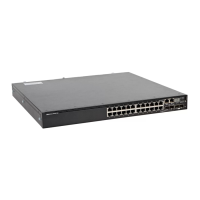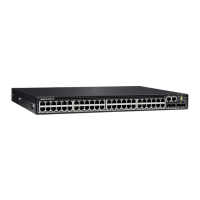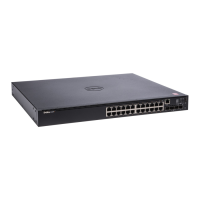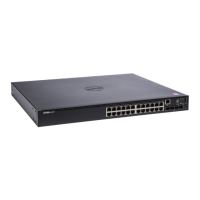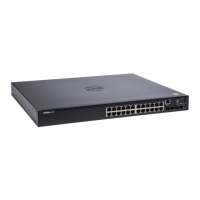Managing a Switch Stack 177
You can preconfigure information about a stack member and its ports before
you add it to the stack. The preconfiguration takes place on the stack master.
If there is saved configuration information on the stack master for the newly
added unit, the stack master applies the configuration to the new unit;
otherwise, the stack master applies the default configuration to the new unit.
Removing a Switch from the Stack
Prior to removing a member from a stack, check that other members of the
stack will not become isolated from the stack due to the removal. Check the
stack-port error counters to ensure that a stack configured in a ring topology
can establish a communication path around the member to be removed.
The main point to remember when you remove a unit from the stack is to
disconnect all the links on the stack member to be removed. Also, be sure to
take the following actions:
• Remove all the STP participating ports and wait to stabilize the STP.
• Remove all the member ports of any Port-Channels (LAGs) so there will
not be any control traffic destined to those ports connected to this member.
• Statically re-route any traffic going through this unit.
When a unit in the stack fails, the stack master removes the failed unit from
the stack. The failed unit reboots with its original running-config. If the stack
is configured in a ring topology, then the stack automatically routes around
the failed unit. If the stack is not configured in a ring topology, then the stack
may split, and the isolated members will reboot and re-elect a new stack
master. No changes or configuration are applied to the other stack members;
however, the dynamic protocols will try to reconverge as the topology could
change because of the failed unit.
If you remove a unit and plan to renumber the stack, issue a no member
unit
command in Stack Configuration mode to delete the removed switch from
the configured stack member information.
How is the Firmware Updated on the Stack?
When you add a new switch to a stack, the Stack Firmware Synchronization
feature automatically synchronizes the firmware version with the version
running on the stack master per the configuration on the master switch. The
synchronization operation may result in either upgrade or downgrade of
firmware on the mismatched stack member.

